First look at the Samsung Galaxy S3 Mini. Review of the smartphone Samsung Galaxy S3 mini. Technical data. Communication between devices in mobile networks is carried out through technologies that provide different data transfer rates
Information about the make, model, and alternative names of a particular device, if any.
Design
Information about the dimensions and weight of the device, presented in different units of measurement. Used materials, suggested colors, certificates.
| Width Width information refers to the horizontal side of the device in its standard orientation during use. | 63 mm (millimeters) 6.3 cm (centimeters) 0.21 ft 2.48in |
| Height Height information refers to the vertical side of the device in its standard orientation during use. | 121.6 mm (millimeters) 12.16 cm (centimeters) 0.4 ft 4.79in |
| Thickness Information about the thickness of the device in different units measurements. | 9.9 mm (millimeters) 0.99 cm (centimeters) 0.03 ft 0.39in |
| Weight Information about the weight of the device in different units of measurement. | 111 g (grams) 0.25 lbs 3.93oz |
| Volume Approximate volume of the device, calculated from dimensions provided by the manufacturer. Refers to devices with the shape of a rectangular parallelepiped. | 75.84 cm³ (cubic centimeters) 4.61 in³ (cubic inches) |
SIM card
The SIM card is used in mobile devices to store data that certifies the authenticity of mobile service subscribers.
Mobile networks
A mobile network is a radio system that allows multiple mobile devices to communicate with each other.
Mobile technologies and data rates
Communication between devices in mobile networks is carried out through technologies that provide different data transfer rates.
Operating system
The operating system is the system software that manages and coordinates the operation of the hardware components in the device.
SoC (System on a Chip)
System on a chip (SoC) includes all the most important hardware components of a mobile device in one chip.
| SoC (System on a Chip) System on a chip (SoC) integrates various hardware components such as processor, GPU, memory, peripherals, interfaces, etc., as well as the software necessary for their operation. | ST-Ericsson NovaThor U8500 |
| Technological process Information about technological process on which the chip is made. The value in nanometers measures half the distance between the elements in the processor. | 45 nm (nanometers) |
| Processor (CPU) The main function of the processor (CPU) of a mobile device is the interpretation and execution of instructions contained in software applications. | ARM Cortex-A9 |
| Processor bit depth The bit depth (bits) of a processor is determined by the size (in bits) of registers, address buses, and data buses. 64-bit processors have more high performance compared to 32-bit processors, which for their part are more productive than 16-bit processors. | 32 bit |
| Instruction Set Architecture Instructions are commands by which the software sets/controls the operation of the processor. Information about the instruction set (ISA) that the processor can execute. | ARMv7 |
| Number of processor cores The processor core performs program instructions. There are processors with one, two or more cores. Availability more cores increases performance by allowing parallel execution of many instructions. | 2 |
| Processor clock speed The clock speed of a processor describes its speed in terms of cycles per second. It is measured in megahertz (MHz) or gigahertz (GHz). | 1000 MHz (megahertz) |
| Graphics Processing Unit (GPU) Graphics Processing Unit (GPU) handles calculations for various 2D/3D graphic applications. In mobile devices, it is used most often by games, consumer interface, video applications, etc. | ARM Mali-400 MP1 |
| Number of GPU cores Like the CPU, the GPU is made up of several working parts called cores. They handle the graphical calculations of different applications. | 1 |
| Volume random access memory(RAM) Random access memory (RAM) is used by the operating system and all installed applications. Data stored in RAM is lost when the device is turned off or restarted. | 1 GB (gigabytes) |
| Type of random access memory (RAM) Information about the type of random access memory (RAM) used by the device. | LPDDR2 |
Built-in memory
Each mobile device has a built-in (non-removable) memory with a fixed amount.
Memory cards
Memory cards are used in mobile devices to increase the storage capacity for storing data.
Screen
The screen of a mobile device is characterized by its technology, resolution, pixel density, diagonal length, color depth, etc.
| Type/technology One of the main characteristics of the screen is the technology by which it is made and on which the image quality of information directly depends. | Super AMOLED |
| Diagonal For mobile devices, the screen size is expressed in terms of its diagonal length, measured in inches. | 4 in 101.6 mm (millimeters) 10.16 cm (centimeters) |
| Width Approximate Screen Width | 2.06in 52.27 mm (millimeters) 5.23 cm (centimeters) |
| Height Approximate Screen Height | 3.43in 87.12 mm (millimeters) 8.71 cm (centimeters) |
| Aspect Ratio The ratio of the dimensions of the long side of the screen to its short side | 1.667:1 5:3 |
| Permission Screen resolution indicates the number of pixels vertically and horizontally on the screen. Higher resolution means sharper image detail. | 480 x 800 pixels |
| Pixel Density Information about the number of pixels per centimeter or inch of the screen. More high density allows you to display information on the screen with clearer details. | 233 ppi (pixels per inch) 91ppm (pixels per centimeter) |
| Color depth Screen color depth reflects the total number of bits used for the color components in a single pixel. Information about the maximum number of colors the screen can display. | 24 bit 16777216 flowers |
| Screen area Approximate percentage of screen space on the front of the device. | 59.64% (percentage) |
| Other characteristics Information about other functions and features of the screen. | capacitive Multitouch |
Sensors
Different sensors perform different quantitative measurements and convert physical indicators into signals that are recognized by the mobile device.
Main camera
The main camera of a mobile device is usually located on the back of the case and is used for taking photos and videos.
| Flash type The most common types of flashes in mobile devices cameras are LED and xenon flares. LED flashes give more soft light and unlike the brighter xenon ones, they are also used for video filming. | LED |
| Image Resolution One of the main characteristics of mobile device cameras is their resolution, which indicates the number of pixels in the horizontal and vertical direction of an image. | 2592 x 1944 pixels 5.04 MP (megapixels) |
| Video resolution Information about the maximum supported resolution for video recording by the device. | 1280 x 720 pixels 0.92 MP (megapixels) |
| Video - frame rate/frames per second. Information about the maximum number of frames per second (fps) supported by the device when shooting video at the maximum resolution. Some of the main standard shooting and video playback speeds are 24p, 25p, 30p, 60p. | 30 fps (frames per second) |
| Characteristics Information about other software and hardware features related to the main camera and improving its functionality. | autofocus digital zoom geo tags panoramic shooting Touch focus Face recognition |
Additional camera
Additional cameras are usually mounted above the screen of the device and are mainly used for video calls, gesture recognition, etc.
Audio
Information about the type of speakers and audio technologies supported by the device.
Radio
The radio of the mobile device is a built-in FM receiver.
Location determination
Information about navigation and location technologies supported by the device.
WiFi
Wi-Fi is a technology that provides wireless communication for short distance data transmission between different devices.
Bluetooth
Bluetooth is a standard for secure wireless data transfer between different types of devices over short distances.
USB
USB (Universal Serial Bus) is an industry standard that allows different electronic devices to communicate.
Headphone jack
This is an audio connector, which is also called an audio jack. The most widely used standard in mobile devices is the 3.5mm headphone jack.
Connecting devices
Information about other important connection technologies supported by the device.
Browser
A web browser is a software application for accessing and viewing information on the Internet.
| Browser Information about some of the key features and standards supported by the device's browser. | HTML HTML5 |
Audio file formats/codecs
Mobile devices support various audio file formats and codecs that store and encode/decode digital audio data, respectively.
Video file formats/codecs
Mobile devices support various video file formats and codecs, which store and encode/decode digital video data, respectively.
Battery
Mobile device batteries differ from each other in their capacity and technology. They provide the electrical charge they need to function.
| Capacity Battery capacity shows maximum charge, which it is able to store, measured in milliamp-hours. | 1500 mAh (milliamp-hours) |
| Type The type of battery is determined by its structure and, more specifically, by the chemicals used. Exist different types batteries, with lithium-ion and lithium-ion polymer batteries most commonly used in mobile devices. | Li-Ion (Li-Ion) |
| Talk time 2G Talk time in 2G is the period of time during which the battery is completely discharged during a continuous conversation in a 2G network. | 14 hours 10 minutes 14.2 h (hours) 850.2 min (minutes) 0.6 days |
| 2G standby time The 2G standby time is the amount of time it takes for the battery to fully discharge when the device is in stand-by mode and connected to a 2G network. | 460 h (hours) 27600 min (minutes) 19.2 days |
| 3G talk time Talk time in 3G is the period of time during which the battery is completely discharged during a continuous conversation in a 3G network. | 7 hours 50 minutes 7.8 h (hours) 469.8 min (minutes) 0.3 days |
| 3G standby time The 3G standby time is the amount of time it takes for the battery to fully discharge when the device is in stand-by mode and connected to a 3G network. | 360 h (hours) 21600 min (minutes) 15 days |
| Characteristics Information about some additional features device battery. | Removable |
In mid-October announced new smartphone Galaxy S III mini, which has the index i-8190. This model Outwardly, it is a smaller copy of the flagship Galaxy S III - the same design, body materials, control keys layout. But this is where the similarity ends, the characteristics of smartphones differ dramatically.
samsung galaxy The S III mini measures 121.55mm x 63mm x 9.85mm, which is reminiscent of the dimensions of the original Galaxy S. As we mentioned, new model will have a similar design to the Galaxy S III. Thus, the South Korean company decided that the consumers of this gadget will be those who need more compact dimensions and a lower price.
As in the flagship model, almost the entire front surface of the device is occupied by the display, above which are front-camera, light and proximity sensors, a speaker and a company logo, and below it is a control key. On the back cover you can see the main camera with LED flash. Cut-outs for speaker and logo.
The assembly of the device is very high quality: there are no squeaks during operation and no backlash.
Weight Galaxy S III mini - 111.5 gr.
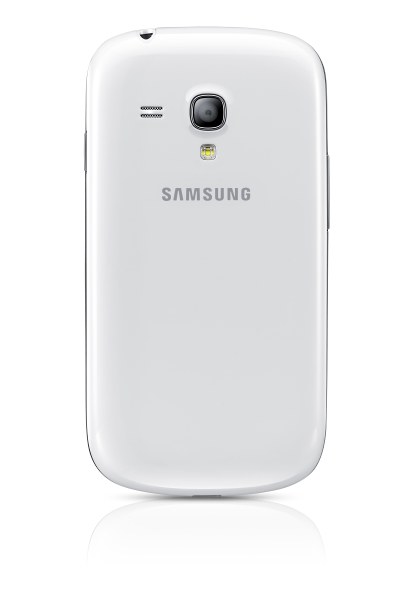
Performance and software
Samsung Galaxy S III mini is based on the 2-core ST-Ericsson NovaThor ModAp processor of the U8500/U8520 family with clock frequency 1 GHz, Mali-400MP graphics accelerator and 1 GB of RAM.
These characteristics, of course, are worse than those of the original Galaxy S III, but still provide good performance and allow the cost to be reduced. Below we present several tests that will help you assess the capabilities of the new smartphone.
The Benchmark Pi test allows you to determine the performance of the CPU (the lower the score, the better), here the gadget is ahead of such smartphones as the Xperia go, Sony Xperia sola and Samsung Galaxy S Duos.
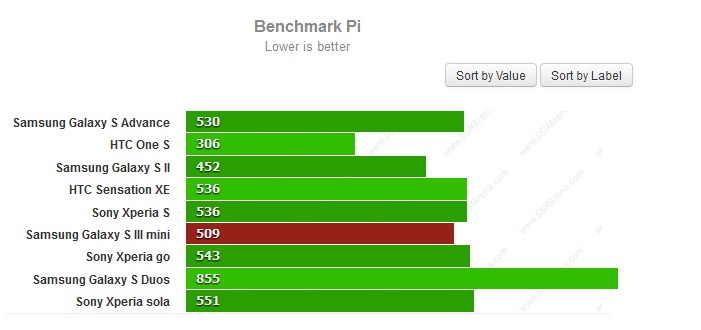
In the Linpack performance benchmark, the new model overtook One V, Samsung Galaxy S Duos.

The SunSpider test is a JavaScript benchmark, in which the Galaxy S III mini came very close to HTC One S.

BrowserMark shows how good a smartphone is at working with the latest web standards. Here the gadget was able to bypass the Apple 4S.
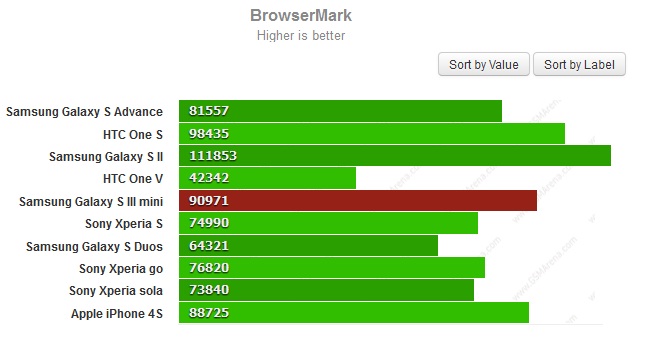
In other benchmarks Vellamo, NenaMark 2, AnTuTu and Quadrant, the new device also showed average results.



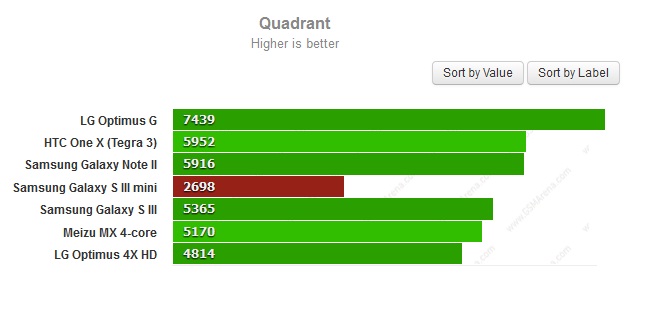
The Samsung Galaxy S III mini has 16 GB of internal storage, which can be expanded using microSD cards.
Right out of the box, the smartphone will run an operating system. Android systems 4.1 Jelly Bean, which, of course, is a big plus.
The Galaxy S3 mini has the following preinstalled apps: browser, audio player, video player, Play market, integration with social networks, navigation software, mail client, other programs and games.
Gadget supported Wi-Fi operation(hotspot+Direct), GPS/A-GPS and , Bluetooth 4.0, FM radio, and 3G networks.
Screen
The pixel density is 233 ppi, but since the AMOLED generation uses a PenTile matrix, you should be able to detect familiar pixelation. Although this does not have of great importance, but this is one of those things that you only need to notice once and it will not leave your head. The Samsung Galaxy S 3 mini uses a 4-inch Super AMOLED capacitive touchscreen display with a resolution of 800x480 pixels and a color reproduction of 16 million shades. It is identical to the screen used in Galaxy smartphones S and Galaxy S Advance, so the image quality is the same.
Given all this, we can say that the display has more than decent image quality for a mid-range device. Colors are rich, blacks are as deep as other AMOLED screens, and viewing angles are very wide.
Camera
Galaxy S III mini is equipped with a 5-megapixel camera with LED flash and autofocus. The novelty allows you to take pictures with a maximum resolution of 2592x1944 pixels.
Photos look good enough, especially considering that this device is not camera-oriented.
You can see photo examples below.






The camera can record video in HD at 30 frames per second, which makes the movement during playback quite smooth.
An example of a video taken with samsung camera Galaxy S3 mini.
The smartphone also has a 0.3-megapixel front camera for video calling.
Battery
The device has lithium-ion battery with a capacity of 1500 mAh, which is enough for 6-7 hours of intensive use (games, Wi-Fi and 3G networks, video, music and conversations).
Price
Samsung Galaxy S III mini video review:
operating system:Operating system. Symbian OS - This is probably the most common operating system for smartphones.
The most common Symbian-based platforms right now are: Series 60 (the most popular platform, used on Nokia, Panasonic, Samsung, Lenovo, LG and Sony Ericsson etc.), Series 80 (used in some Nokia models), Series 90 (now used only on Nokia 7710), UIQ ( Nokia models, Benq, Motorola, Arima, Sony Erisson, and MOAP (closed platform, installed on Fujitsu, Sony Ericsson, Mitsubishi, and Sharp phones).
Android This is the operating system Google, also sometimes referred to as Droid.
Immediately after the appearance of smartphones and tablets on the market, Android gained immense popularity due to its beautiful appearance and effective work.
Main advantage of Android compared to other operating systems is almost completely open architecture and deep integration with Google services. There are already enough a large number of software for this OS, so that almost any user does not feel deprived, while the software market is developing quite dynamically.
Apple (iOS) This is the operating system Apple, used in the iPhone, iPod Touch and iPad.
iOS was shown on June 29, 2007 when the first iPhone appeared.
BlackBerry This is the operating system of Research in Motion (RIM).
Windows Phone and Windows Mobile is Microsoft's latest mobile operating system.
The main advantages of Windows Mobile are the interface familiar to desktop PCs, good multitasking, support for devices with high resolution screen, a wide variety of smartphone models, an abundance of software for every taste and for any task. Today's filling of the market of Windows Mobile - communicators allows the user to find decent models in almost any price range.
Bada (bada translated from Korean as the ocean) is new platform for smartphones, which allows developers to create rich applications that enhance the user experience when working with mobile devices.
Bada operating system for Samsung phones includes a new UI framework for a new generation user interface touch phones samsung touch. The UI framework makes using the phone easy and effortless without compromising its functionality. It is a revolutionary and innovative system that greatly enhances the conventional user interface of touch phones.
Samsung has decided to release the Galaxy S III mini. From the title it would seem clear that a copy should be waiting for us big smartphone on a slightly reduced scale. In fact, it turned out that Samsung went to the trick of exploiting the name of the hit phone.
The company decided to submit its lightweight version under the guise of a simplified flagship. The novelty looks like a smaller Galaxy S III - the shape of the case and the color are the same. The characteristics have also become more modest, but the cost has also been significantly reduced. The novelty, as it were, hints that you have a small hi-end phone. However, it is not so small and the most productive Samsung device in the line, if we compare it diagonally. But let's talk about design.
Design
You don't have to be very perspicacious to figure out the source of inspiration for a model's appearance. Details of the Galaxy S III are easily recognizable, from the button with a metal outline on the front panel to the "metal" band that surrounds the sides of the smartphone. Oddly enough, I would like to find fault with the beveled edges - they were not reduced in accordance with the proportions of the body, but left the same as in the large Galaxy S III. As a result, the smartphone seems unnecessarily tending to an ellipse, rather than a thin rectangle. And because of the smooth finish and white color it even resembles an elongated "remnant".

The ergonomics of the Galaxy S III mini are excellent. However, you don’t expect anything else from a company that can make even devices with 5-inch screens convenient. The thickness is 9.9 mm, which for its devices price category and with a 4-inch screen is a good indicator. In fact, a good balance is involved between the height of the rib and a comfortable stay in the palm of your hand. Of course, I was pleased with the weight - only 111.5 grams and the palm does not burden, and they are barely felt in the pocket.

The main material is glossy plastic, whose soiling is of interest to us mainly in the context of the back cover. It is varnished, and therefore quickly and abundantly covered with fingerprints. But it's not very noticeable because of the white color.

It was not possible to make a final opinion about the build quality due to the fact that we have a test sample. Basically, when squeezing, creaks appeared in the upper part of the case, however, in commercial batches, the flaws are likely to be leveled.
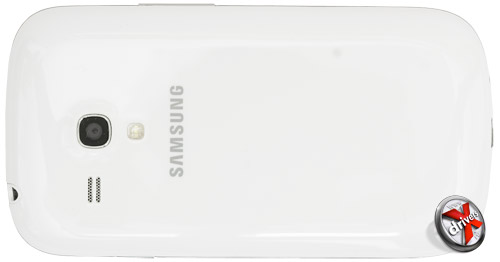
Despite the general similarity with the "big brother", the Galaxy S III mini has enough differences in details, as well as very controversial decisions. We will discuss them in detail in the next section.
Connectors and controls
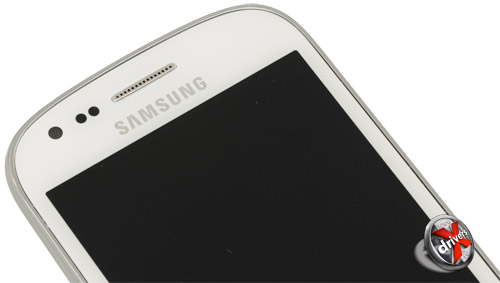
A feature of the Galaxy S III mini is that the front camera, light and proximity sensors are located to the left of the speaker.

In our copy with a white case, the disease of the older model with the same color has been fully preserved.

Two touch keys are not highlighted at all, only the backlight after direct contact reminds of their purpose. And, as we remember, the blue body of the Galaxy S III does not have this drawback. Not too pleased with the central physical button. The fact is that the metal contour is motionless - only the central white area is pressed. This creates some discomfort due to the slight "cutting" effect. On the other hand, in principle, the presence physical button there is a noticeable plus. It is easy to find by touch, and two more buttons are intuitively perceived on the sides - adherents of the Samsung brand will not complain about the need to change habits.
If we had no complaints about the ergonomics of the case as such, then the location of the buttons on the ends turned out to be not ideal.

On the right is the on / off key of the phone. In principle, its installation "under the finger" depends on specific person and cannot be subject to objective criticism.

But the volume rocker is somewhat understated - the index finger has to be lowered to use the keys.

The top side of the smartphone only contains a 3.5mm headphone jack.

At the bottom, even by elimination, we can assume the presence of a microUSB connector and a microphone slot.

On the back side, there are two parallel system speaker openings to the left of the camera, and an LED flash is installed directly below it.
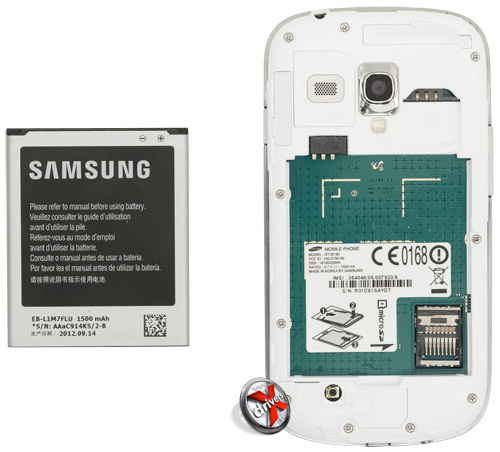

However, the most interesting design tricks are found under the lid. For starters, an unusual choice with the ability to change the SIM card without removing the battery - this is not common.
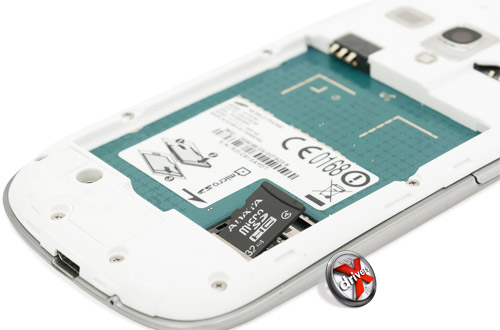
But even more unusual is the presence of microSD under the battery. It has a somewhat unusual fastening - the card is held by the case itself. How to install it correctly, shows a small instruction printed directly on reverse side printed circuit board. Nothing complicated if you understand the two steps. But, of course, the need to remove the battery to change the card cannot be called the optimal solution.

If you close your eyes to the flaws in some moments, Galaxy S III mini cannot be reproached for an overly ill-conceived attitude to trifles. Rather, our expectations were not justified in relation to the hit progenitor.
Screen
The smartphone did not become a special discovery in terms of the display - the Super AMOLED matrix has already been repeatedly reviewed by us on different models. Large viewing angles and saturated colors coupled with acceptable readability in the sun are the most notable features of the technology used. With a diagonal of 4 inches, a resolution of 480x800 pixels means a pixel density of 233 ppi. If you have not dealt with HD-smartphones until now, the clarity of the picture will not cause any questions. After getting acquainted with the flagships of this year, some pixelation is still striking.
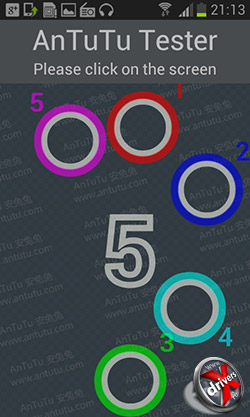
The display supports up to five simultaneous touches.
Galaxy S III disappointed us in July with a brightness of only 167 cd/m 2 . The S III mini fares even worse - 156.53 cd/m2 with the same display technology. Not surprisingly, in sunny weather, the picture becomes illegible. The brightness of the black dot due to Super AMOLED technology is zero, which means that the contrast tends to infinity.
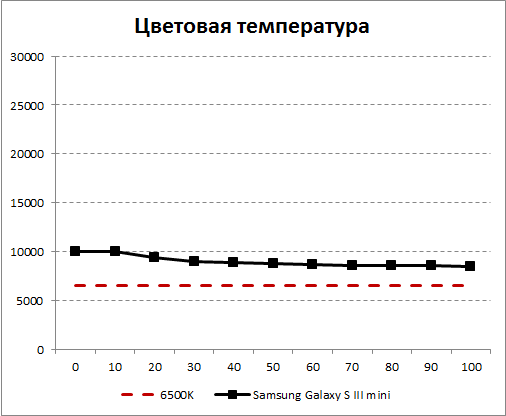
During the test, the Galaxy S III failed to impress us with actual screen measurements across color temperature. In its mini version, a relatively flat graph is observed, apart from a small blockage of 10%, which occurs on all screens. In the rest of the interval, it slowly tends to the reference one, but does not fall below the 7000K level. Therefore, a balance shift towards blue is inevitable.

Gamma measurements have become almost a copy of the graph Galaxy S III. Before us is again a significant "overexposure", designed to artificially increase the insufficient real brightness of the display.
Camera
The ability of the smartphone to shoot at the flagship does not apply. On the back cover is a 5-megapixel "eye", capable of producing frames with a resolution of 2592x1944 pixels. The maximum video resolution is 1280x720 pixels, although the original Galaxy S III can shoot Full HD video without any problems. There is autofocus and flash.

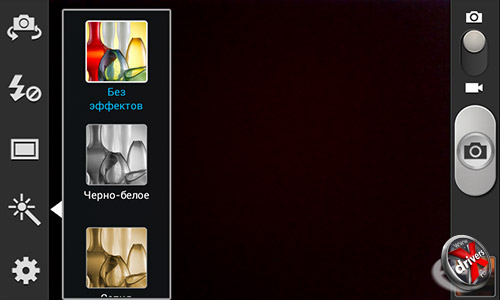

We have repeatedly seen the camera interface from Samsung's point of view in other smartphones of the company, Galaxy S3 mini did not become a fulcrum for the implementation of radically new ideas. Familiar options like ISO and white balance sit alongside additions like a variety of shooting modes and effects.
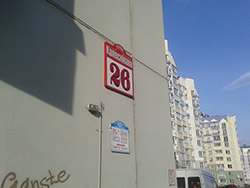
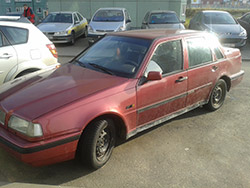
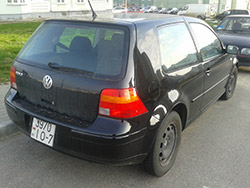
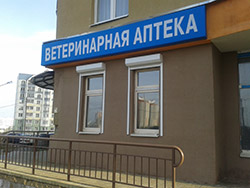

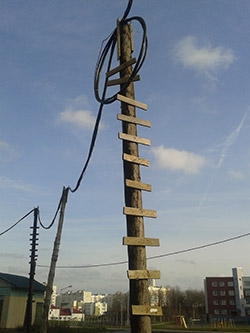




The received frames clearly speak of good-quality optics installed in the smartphone. First of all, the Galaxy S III mini managed to produce excellent pictures in the evening - the result is indistinguishable offhand from a barely cloudy day. There are no complaints about the detail of images and macro photography. Perhaps, since the time no smartphone with a 5-megapixel module has demonstrated such high-quality shooting.

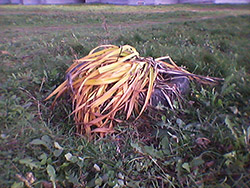

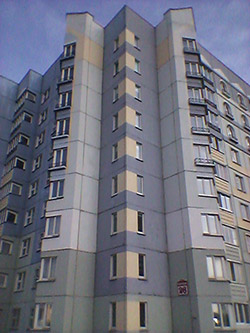


The compliment, of course, does not concern the front camera.
Unfortunately, video filming does not deserve similar praise at all. The videos turned out with a pronounced lack of detail.
The front camera showed a picture corresponding to the declared 0.3 MP.
Characteristics
Considering that in our hands there was a device that “claims” to be related to the best-selling Samsung smartphone, it was not possible to avoid their direct comparison. It is all the more interesting to find out what compromises users will have to endure for the saved money in addition to the reduced screen.
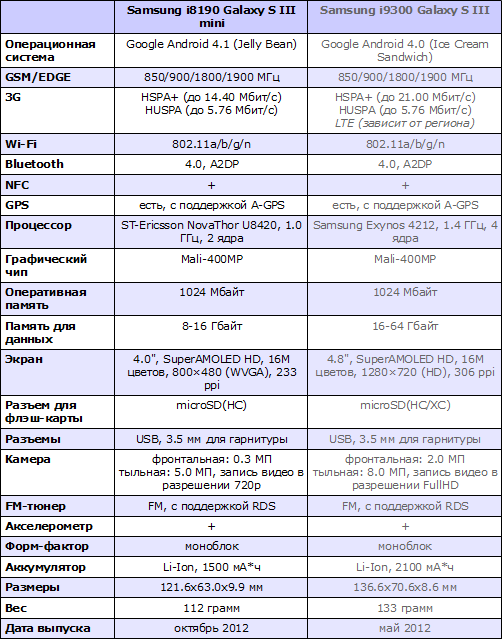
By their own specifications Galaxy S III mini appears before us in the form of a completely ordinary smartphone of the current middle class. From a software point of view, the model is remarkable the presence of Android 4.1 out of the box. However, Google has already released 4.2 with its characteristic haste, once again making a contribution to the fragmentation of the platform. We hope current version systems will arrive on the Galaxy S III mini without delay.
If we close our eyes to the lack of LTE support, then from the rest wireless standards there is the widest possible list. Here is the fourth generation of Bluetooth, and NFC, and a complete list of Wi-Fi specifications. And even the support of the Russian satellite navigation GLONASS is. True, she is not very justified. A pedestrian will not be able to appreciate the merits of GLONASS and GPS pairing, and a motorist is unlikely to consider a 4-inch smartphone as a replacement for a navigator.
"Iron" resembles a mandatory set of any more or less decent smartphone. So this is a NovaThor dual-core processor with a frequency of 1.0 GHz. At the same time, the older Galaxy S III boasts a 1.4GHz quad-core chip made by Samsung. However, both processors are equipped with a Mali graphics chip. As we could see, Mali-400MP is not the fastest graphics solution.
Now about the main thing - what the model has from the Galaxy S III, and what caused the mention of “mini”. They took away LTE from us, “cut down” the processor from four to two cores, lowered the parameters of the cameras and reduced the battery capacity. Although the last point is controversial - with a discount on the screen diagonal. As compensation, they added GLONASS, Android 4.1 and left the display technology. By and large, with the exception of appearance, there are not very many points of intersection with the Galaxy S III. Of course, the dimensions of the smartphone do not allow the same components to be built into it, but the screen could be equipped with a higher resolution - at least 960x540 pixels.
Performance Testing
The Novathor U8420 chip manufactured by ST-Ericsson was not seen on models other than the Galaxy S III mini, so it's more interesting to evaluate its capabilities. And, despite the difference in the number of cores, we decided to arrange a direct confrontation between "father" and "son" by putting Galaxy S III mini against S III. In theory, the main advantage of the flagship is a more powerful processor.

AnTutu System Review immediately put everything in its place. In all tests based on processor calculations, two - and even three times the advantage is on the side of the S III. But in the graphics test, both smartphones produced comparable performance, which was to be expected.
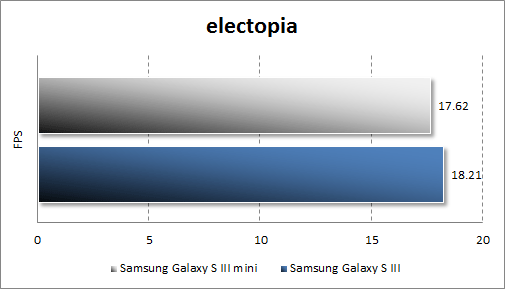
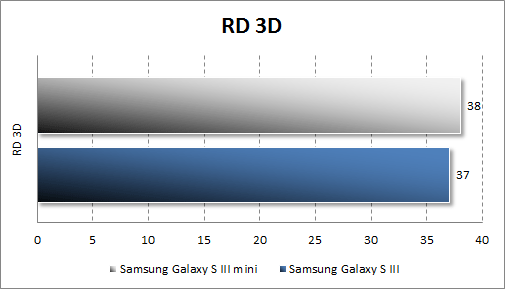
Graphical benchmarks show you how much power they need multi-core processor. It turned out - almost no need. In the presence of the same graphics chip in electopia the gap is negligible, and in RD 3D the advantage of one point is on the side of the S III mini.
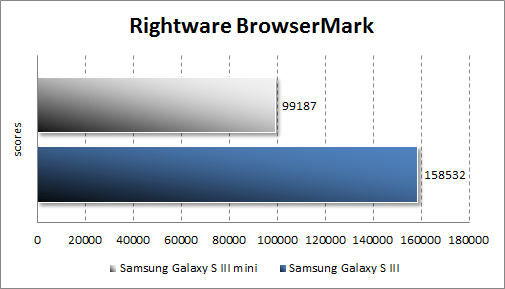
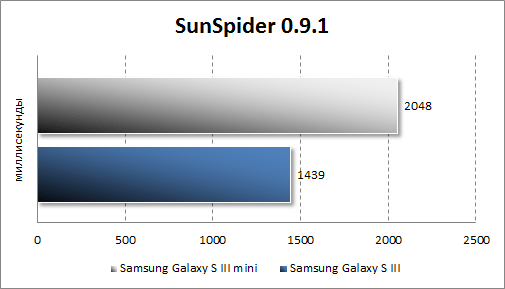
A browser check confirmed the readings of AnTutu System Review. As a result, we can state a sufficient margin computing power Galaxy S III mini. The only trump card of the senior competitor was naturally revealed only in "processor" tasks.
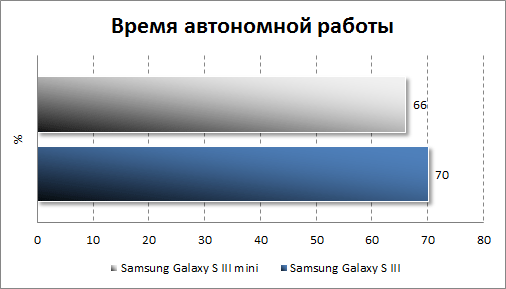
At one time during Galaxy review S III we said that the flagship has a level battery life on a par with the record holder in the face Galaxy Mini 2. So, Galaxy S III mini lagged behind the opponent by only 4 percentage points. Comments are unnecessary - the autonomy of the Galaxy S 3 mini is quite good.
Galaxy S3 mini software
As we have already said, Android 4.1 is installed in the smartphone with the unchanged TouchWIZ add-on. Shell abilities, as well as basic android features 4.0, we examined earlier with an example. Therefore, in order not to repeat ourselves, let's try using the Galaxy S III mini as an example to get acquainted with the improvements in version 4.1.


First on the list is Google Now, this is a kind of assistant-hint, working on the basis of the analysis of our behavior. After all, Google, as you know, likes to collect all kinds of information about user activity. To launch the program, you must select "Google" on the lock screen or hold touch button"Home" by selecting the same inscription. Google Now offers a great variety of message options, but their implementation requires using a smartphone for at least a few months. Then information potentially of interest will be given in the so-called information cards.
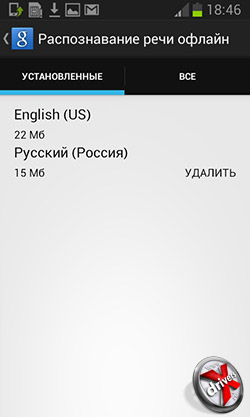
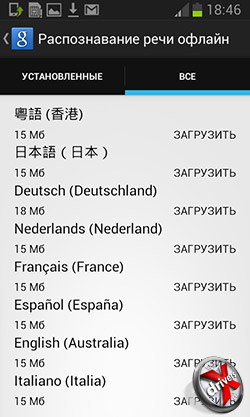


The keyboard of the system received one-button language switching and self-learning prompts for entered words. However, Samsung removed the Android keyboard, so we were unable to test it.



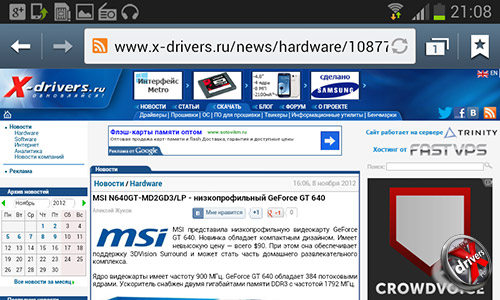
Standard android browser from now on Google Chrome, which is especially attractive with the synchronization function between desktop and mobile versions. Very easy to switch between open tabs, for this you just need to flip them like pages left or right.


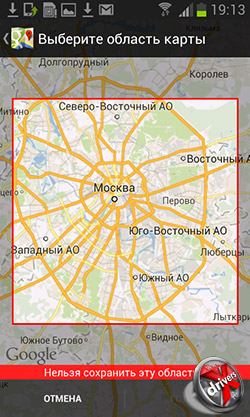
Google Maps finally stopped being a free, but not the most practical service due to the need to connect to the Internet. Users were allowed to select a site on the map and download its map in order to have access even offline. However, far from any scale of the territory is supported.

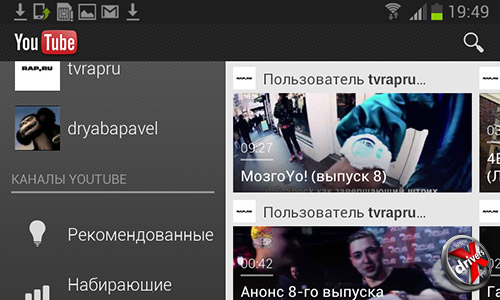
Both Google+ and the YouTube client have a retractable panel on the left. It gives quick access to the main sections of services and settings.
Android 4.1 on the Galaxy S III mini ran without errors or noticeable delays. However, "superspeeds" were also not noticed. By tradition, not everyone will like the heap of Samsung programs and services.
Conclusion
If we consider the Samsung Galaxy S III mini in isolation, we see stylish smartphone for those who seem to want to have "in reserve" the capabilities of advanced phones. There is a good camera, a medium-sized (but solid) screen, and the hardware platform will cope with multimedia tasks and 3D games, and its battery life is quite good.
At the same time, since we are dealing with a stripped-down version of the flagship, which is also clearly indicated by its name, it would be possible to “pull up” some characteristics. For example, increase the processor frequency by 200-400 MHz and raise the screen resolution a little. Yes, and cutting off the possibility of shooting FullHD-video was not worth it. But just LTE can be left to the flagships.
In a good way, the smartphone fell into the gap of smartphones, where the choice is not too great. However, the cost seems too high and will make the device really competitive only with time - when Samsung starts to gradually reduce the price tag.
Price
Judging by the prices of stores, the version with 8 GB of memory can be bought for an average of 16,000 rubles. It’s not yet possible to buy a model bypassing official sales, so it’s too early to think about options for buying a Galaxy S III mini with a lower price.
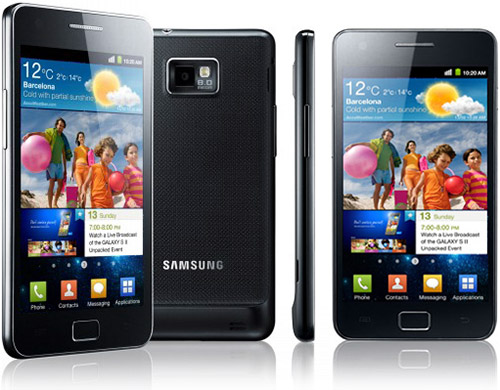
The most interesting thing is that the rival new Galaxy S III mini are products from Samsung itself. In particular, the official one costs 2-3 thousand more, but offers a 4.3-inch screen, more fast processor, yes and android firmware 4.1 he is promised.

Galaxy Advance looks no less interesting - having about the same characteristics, it can be found for about 11-12 thousand rubles. But no Android 4.1 and even 4.0 - only 2.3. It is possible that this will not change.

If you look towards other manufacturers, then the Chinese Meizu MX can be an interesting analogue here. A dual-core model with 16 GB of memory can be purchased for 14-15 thousand. Moreover, the phone has a 4-inch screen, but with a resolution of 640x960 pixels.
Pros:
- attractive design;
- Super AMOLED screen;
- relatively good performance;
- quality camera;
- Android 4.1 "out of the box" with a proprietary shell TouchWIZ;
- good autonomy.
Minuses:
- processor frequency could be higher;
- inability to shoot FullHD-video;
- low brightness and disturbed white balance of the screen;
- inconvenient location of the slot for a memory card;
- overcharge.
Samsung Galaxy S III mini software screenshots
Main menu and applications

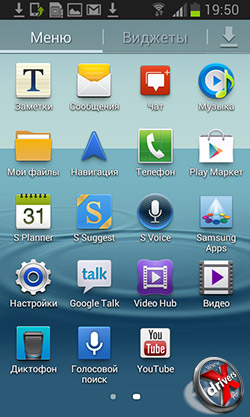
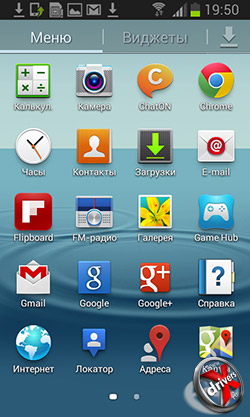

Wallpaper
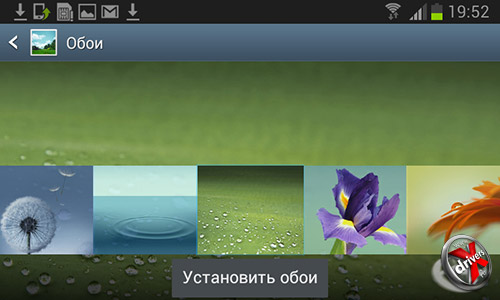
Calculator

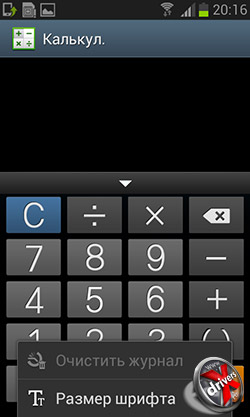
Alarm


“Isn’t there one like it, but without wings?” - everyone remembers the catchphrase from the Soviet film that has already become a catchphrase. In the case of our today's guest, the situation is about the same: isn't there something similar, only smaller? This is how Samsung Galaxy S3 mini is positioned in advertising in relation to the flagship of the line. Whether the novelty has really lost only in size, and not in functionality, let's try to figure it out in practice.
In fact, not everything is as rosy as it seems at first glance, and the “mini” with the “maxi” version are more likely to make the body lines, the manufacturer and the name related, because the filling is noticeably different, up to the fact that the mini version uses the classic SIM- card, and in mini - standard microSIM. comparison table in this case, it will be indicative, so as not to be distracted by the comparison of parameters in the future.
3D photo
Samsung Galaxy SIII mini:: Overview:: Design and Features
The case-monoblock of the smartphone, although it is called "mini", by current standards, has medium or slightly below average dimensions. At the same time, it lies much more comfortably in the hand than tiny solutions from other manufacturers, and this was noted by many respondents. The point here is not only in size, but also in smooth lines: the rounded bath of the back rests in the palm of your hand like a bar of soap. By the way, it is precisely due to it and the curved shape of the plastic edging of the case that the device looks arched in the longitudinal section. Case materials - plastic: milky-white glossy tray at the back, matte metal-like silver edging belt and "glass" of the front panel with white application along the screen contour. It was not possible to evaluate the susceptibility of materials to abrasion during the test, but if we take into account the older version, not everything is so rosy with this parameter. There are no complaints about the assembly, the elements are tightly fitted to each other, there are no gaps, and no squeaks were noticed when squeezed.
Yes, it will be possible to find other colors on sale - only 5 colors.
Now about the components of the structure. Top part the front panel is represented by a silver stripe conversational speaker with a perforation line, as well as proximity sensors and a rear camera on the left. At the bottom of the hardware key "home" bizarre shape surrounded by touch-sensitive counterparts "menu" and "return".
The screen of the device is a sAMOLED-matrix with a diagonal of 4.0 "and a resolution of 800 x 480 pixels. There is the notorious PenTile (if you don't know what it is or don't see it, then don't bother yourself), the picture is not the most stellar in quality, good angles review and a sufficient supply of brightness. The display technology is capacitive, multi-touch supports up to 10 simultaneous touches and works out input without complaints.
The side faces accommodated only one key each: on the left is the volume rocker, and on the right is the power button. The elements are small, but comfortable to use, do not cause problems and cope with the tasks. On the upper side there is a 3.5mm audio jack and a ledge for removing the back cover, and on the lower side there is a microUSB interface connector in the center and a microphone to the left of it.
The back panel is interesting only in the upper third. There are two horizontal slots of the call speaker, a camera lens and an LED flash light.
Prying on the existing ledge and pulling back cover body up, we can snap it off. Waiting for us inside accumulator battery(Li-ion, 1500 mAh) in the appropriate compartment and a little higher slot for a SIM card, half hidden in the case. Oddly enough, having access to the card, it is not hot-swappable. Where is the slot for microSD cards, you ask? It is under the battery and there is no need to talk about hot swap here either.
Samsung Galaxy SIII mini:: Overview:: User interface
Inside the smartphone, Android 4.1.1, Jelly Bean and the proprietary Touch Wiz interface are waiting for us, which managed to evolve to a normal shell that everyone wanted to demolish from the first minutes of use.
For starters, we're greeted by a highly customizable lock screen that can be customized with the weather, clock, shortcuts, or set security options.
Desktops can be created up to 7, and objectionable ones are deleted in 2 accounts if desired. You can make one of the available ones the main one in the preview mode, while circular scrolling is available. The content is standard: shortcuts, widgets, folders - whatever your heart desires, and even added graphic effects. The "dock" of frequently used functions includes the phone, contacts, messages and Internet browser, not counting the transition to the main menu. Traditionally for the manufacturer, you can choose the design font: pampering, but someone will be amused.
Desktop wallpapers can be both static and animated, and the changer interface will allow you to set images immediately and on the lock screen - you never know, you love a single style.
A variety of activation shortcuts have been placed in the notification area: here you can include a lot, which is why they did not fit on one screen and horizontal scrolling is used. In addition, we see here access to the settings and the display backlight slider ( automatic brightness and the truth is not always enough).
The main menu is paged and contains tabs: menu, widgets, loaded. The tinctures are more boring and are presented in the usual vertical list with some noticeable sliders, as well as type separators.
Samsung Galaxy SIII mini:: Overview:: Phone features
The phone application has a standard tabbed structure and visual design from the manufacturer, which looks good. In addition to the dialer, we are waiting for the call log, favorites and contacts.
The traditional strong point of Android smartphones is the address book: it's easier for us to say which fields are missing than to list the available ones. For advanced users, the synchronization mode with a Google account is suitable for restoring existing contacts, and the settings allow you to set almost all the necessary call parameters.
Samsung Galaxy SIII mini:: Overview:: Messages
Messages are standardly sorted by subscriber/phone and are conversation-correspondence. From the manufacturer, we will get letterheads and even clouds - here, in terms of the graphic component, expanse.
The Samsung keyboard differs from that in the bare OS, but also from the method swipe input the manufacturer refused. This element requires habit and more because of the size: on the screen of the "mini" version, it is not very ergonomic.
For mail accounts separation is traditionally provided: Gmail and all others. The functionality of the applications is practically the same, and appearance not particularly. How exactly to use - the user decides, but for Google account, which is linked to the gadget, Gmail is configured when you turn it on for the first time.
Samsung Galaxy SIII mini:: Overview:: Organizer, office
office suite besides basic applications, clock (with alarm, world time, stopwatch, timer) and calculator represented by S Planner advanced calendar, notes, file manager"my files". A good start for full-fledged work, you see, the truth is that there is nothing to work with documents.
Samsung Galaxy SIII mini:: Overview:: Communications
Operating frequencies of the novelty EDGE / GPRS 850 / 900 / 1 800 / 1 900 MHz, there is support for WiFi (802.11a / b / g / n) + WiFi Direct, Bluetooth 4.0, DLNA and USB 2.0. Recall that for ease of launching the modules, their icons are placed in the notification area, and the performance did not cause any complaints during the entire testing period.
Samsung Galaxy SIII mini:: Overview:: Maps & GPS
There is nothing new in our guest except for the standard and boring Google Maps with beta navigation. Maps are updated to current version when first connected to Google Play and are a completely working tool that can always be replaced, since there are already quite a few alternatives.
Samsung Galaxy SIII mini:: Overview:: Online
There are two Internet browsers: this is an unnamed branded “browser” and a familiar desktop OS user, Chrome. The wealth of choice is good news, but by and large, the functions of applications are duplicated, although Chrome is more convenient due to the ability to synchronize between your devices.
Samsung Galaxy SIII mini:: Overview:: Camera
main, rear camera 5-megapixel, supports autofocus and is complemented by an LED flash. The interface is traditionally customizable for the manufacturer, and the variety of parameters will allow you to personalize the shooting for yourself. The quality of the photo can be assessed by test frames and in our opinion, for the declared characteristics, it is more than good. The focusing speed is fast, the shooting is equally good for both close objects and landscapes, and the flash does not overexpose the subject.
Samsung Galaxy SIII mini:: Overview:: Multimedia
The page format of the player is supplemented with graphics from the manufacturer, which is good for him. After selecting the type of content by tags or other parameters, we will switch to the playback mode. Keys quick access at the same time, you can find it in the notification area, and the player settings are very extensive. The sound quality is normal: not worse, but not better than classmates.
The attractive appearance of the voice recorder is supplemented by good settings: from storage and recording quality to restrictions and file name selection. Line recording is not supported.
For the FM radio to work, you need a headset that acts as an antenna. The application settings are simple: memory selection for recording the air, RDS, alternative frequencies and auto-searching with saving.
Samsung Galaxy SIII mini:: Overview:: Apps
By tradition, Samsung completes its devices with a large set of various software out of the box. With Galaxy S3 mini you will get:
Samsung Galaxy SIII mini:: Overview:: Impressions and conclusions
The battery life indicators, despite the fresh OS and not the smallest battery size, are average: this is a day or a little more than a day, 14-15 hours with a classic user load (30-40 minutes voice communication, about 20 messages, periodically checking mail and social media accounts, taking a rare photo and maybe some music).
The level and quality of network reception is decent, there were no breaks or failures (not counting natural barriers, for example, subway crossings). The call volume is rather average, although it should be enough for most users. Medium in power and vibrating, it plays a complementary role. The earpiece is of sufficient power for various life situations, but the microphone is below average, it was the goons of the interlocutors.
So, to the results: if we ignore the fact that Samsung decided to promote a niche model at the expense of the flagship and, returning to the beginning of the article, take into account that the similarity of smartphones is only in the lines of the body, then we have an interesting device with not the top stuffing, pleasant externally and convenient in work. He won't get any fame or sales similar to the flagship, and only the letters in the name will not allow him to get lost in the gray mass of various Android-middlings. If we soberly evaluate the model, then this is another mid-range smartphone, which has many competitors, an adequate price and the expected filling. On the other hand, if a young man has a Samsung Galaxy S3, then the S3 mini would be a good addition to the tandem in the hands of his companion: who knows, maybe even counting on this?
|
|